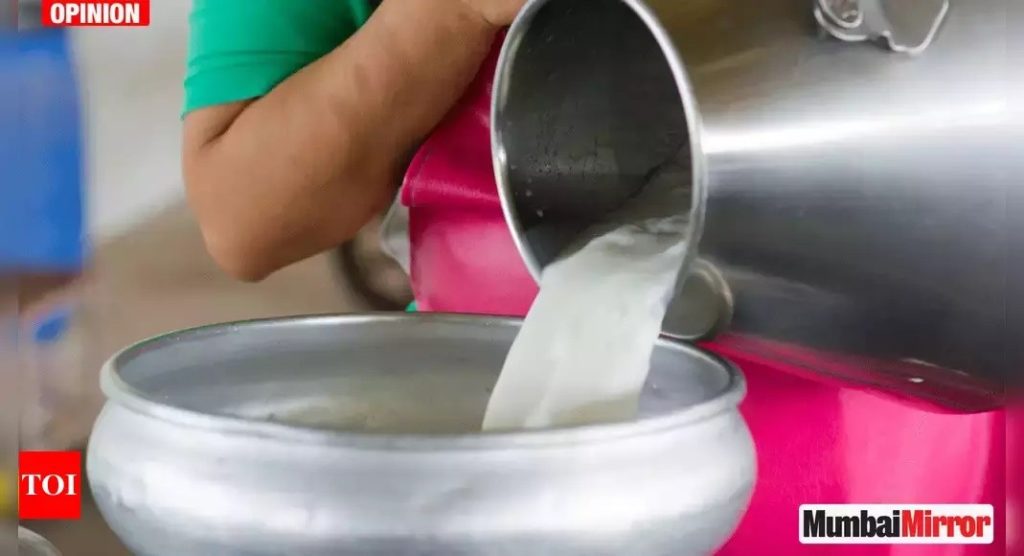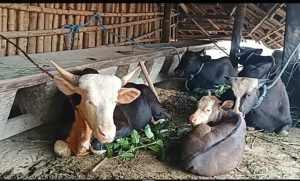
In Ratlam, Madhya Pradesh, the Milk Producers Association which represents dozens of villages in that district, announced that they will raise the price of milk by Rs 12 per litre – a 25 per cent hike. They will have to negotiate this with city vendors, and perhaps face some pushback from urban consumers. But they say that during much of last year, they didn’t raise prices despite an increase in the cost of cattle feed. And now that petrol and diesel prices are rising, it has hit the transportation cost of milk as well. Hence, toned milk will now be sold at Rs 55 a litre, and pure milk at perhaps Rs 80 a litre.
Meanwhile in Hisar, Haryana, one khap panchayat has declared that it will ask all its dairy farmers to raise the price of milk to Rs 100 a litre. This is the price they intend to charge all the government cooperative societies. Other consumers will be charged Rs 55 or Rs 60. This race to the 100-rupee-mark is not just due to cost escalation. It is meant as a gesture of protest against the farm laws. The farm agitation is now more than four months old and still stuck in an impasse. Dairy farmers think that a hike in milk prices will pinch where it hurts, and put pressure on the government to relent.
In Lasalgaon, near Nashik in Maharashtra, the wholesale price of onions spiked by 25 to 30 per cent in one month. This was due to unseasonal rain and the damage caused to the crop. Lasalgaon is the country’s largest wholesale onion market. While current prices — even after the recent spike — are at Rs 4,500 per quintal, it is a sobering thought that back in December 2019, the prices had surged all the way to nearly Rs 9,000 a quintal. So we are only halfway to that peak, but the tears are already streaming down from the eyes of hapless customers.
Oh, and the farm laws are relevant here again. Onion trade is no longer subject to stock limits as per the new law. This new law amended the Essential Commodities Act to exclude onions, potatoes, pulses and oilseeds from the its purview. It has removed storage limits for private traders. Will expectation of higher onion prices lead to hoarding? But the same new farm law, does have an escape clause which allows the government to ruthlessly intervene, if prices spike by too much. That’s the safeguard.
Beyond milk and onions, prices of masur (lentil) and urad dal are up 10 per cent since January, and tur dal is up by 20 per cent. Wholesale edible oils of various kinds are up by 30 to 60 per cent. These are monthly jumps, and if you calculate the implied annualised inflation rate, it would be a mind-boggling number. Yet the official Consumer Price Index-based inflation for January was at a 16-month low of 4.06 per cent. This index has food as half of its components while the remaining items are housing, education, medicines and transportation.
It remains to be seen whether the spike in prices of milk, onions, pulses and oilseeds are temporary or will sustain for some more time. It would be ironic to see a spurt in food inflation at a time when foodgrain production is at a record high of 303 million tonnes, and is 10 per cent higher than the average of the past five years.
The task of controlling inflation lies with the Reserve Bank of India, whose responsibility is to keep it within a band of two to six per cent. With a very high fiscal deficit on the horizon, and demand rising with economic recovery, prices, and hence inflation, may start rising. So the RBI might need to tighten its money supply. But that will increase interest rates and cost of capital, which may add to inflationary pressure.
Input costs of oil and other commodities, like steel, cement and chemicals, are rising. Wage increments have to keep pace with rising inflation expectations. Adding to all this are the increases in import duties. In the past three years, import duties have gone up across the board, affecting one third of all imported items. That makes production costly, since some imported items have no local substitutes.
How, then, to tame this looming inflation monster? This task is more difficult than is apparent, because it involves curbing inflationary expectations, not just imposing price ceilings. Managing expectations is more a matter of psychology rather than economics. But some concrete steps are needed, and these could be as follows.
First, reduce excise on petrol and diesel by Rs 10. Second, solve the farm agitation with urgency. Maybe refer the laws to a standing committee and keep them in abeyance until a Parliamentary consensus is reached. Third, negotiate with the dairy sector to limit a price hike. Fourth, reduce import duties, at least on items not yet manufactured in India. Fifth, reduce the main GST rate to 12 per cent progressively from the current 18 per cent. And last, keep the currency stable, so that we don’t let imported inflation come into our economy.
Ajit Ranade is an economist and writes on the wheels that make Mumbai run — money and economy
(Disclaimer: The views expressed here are the author’s own)

















